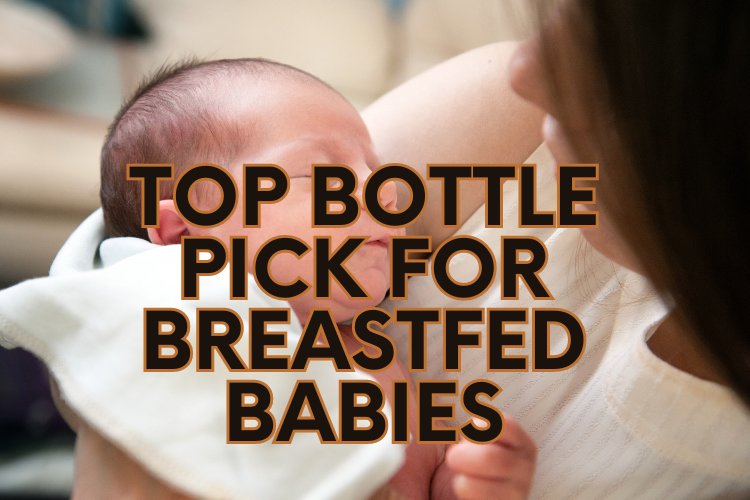Top Pick for Breastfed Babies Who Won't Take a Bottle
Great Bottles for Babies Who Don't Like Bottles. If you're a mom who breastfeeds, there might be a time when your baby needs to try using a bottle

Baby who drinks from the breast and doesn't like the bottle.
Great Bottles for Babies Who Don't Like Bottles. If you're a mom who breastfeeds, there might be a time when your baby needs to try using a bottle. This is a big step and can make you feel a bit nervous.
The good news is, there are many bottle brands made just for babies who are used to breastfeeding. Here are some we really like

Breastfeeding Advantages
Breastfeeding keeps your baby healthy. Research shows that breastfed babies get sick less often and are generally healthier than those who are bottle-fed. They also have a lower risk of becoming overweight and tend to have better brain development.
Breastfed babies are more alert and may have higher IQ scores compared to those who aren't breastfed. The American Academy of Pediatrics suggests breastfeeding exclusively for the first six months and continuing until your baby no longer needs milk, which could be up to two years or more.
If you're introducing bottles to a breastfeeding baby, try replacing a few breastfeeding sessions with bottle feeds. It may take some time for your baby to get used to it, but they'll learn that the bottle isn't as good for them, and they'll want to go back to breastfeeding.
Using a slow flow nipple on the bottle can help your baby transition. This makes them use their tongue and jaws in a special way to get the milk. You can find this type of nipple at a baby store or ask a lactation consultant for guidance.
Another good idea is to use a pump instead of breastfeeding for some sessions. This way, you can still make the milk your baby needs whether you're at home or not.
When you decide to start using formula, you can do that too. Just know that if you switch to formula, your baby will have less breastmilk and may poop less. It might be a bit confusing for them, but Aponte says these changes are normal.
Ways to Stop Your Baby from Rejecting the Bottle
Getting your baby to accept a bottle is a common challenge, often because it's a new skill for them. However, there are simple steps you can take to prevent bottle refusal and make life easier for both of you.
Firstly, choose a bottle that mimics the shape and feel of the mother's nipple to reduce "nipple confusion" and make the transition between breast and bottle smoother.
Consider the flow speed of the nipple – if your baby struggles to suck, try a faster flow bottle nipple. A quicker flow means less effort for them before the milk comes out.

Check the temperature of the bottle; some babies prefer warm milk, while others like it cooler. Experiment with temperatures and different bottles to find what your baby prefers.
If you're breastfeeding, provide skin-to-skin contact while bottle-feeding. According to lactation consultant Leigh Anne O’Connor, this can make the transition more comfortable for your baby.
Give your baby a few weeks of practice before introducing the bottle for the first time. Ensure you offer the bottle in a comfortable position and that the bottle size is suitable for your baby.
Once you find a bottle that works, encourage your baby to try it with these tips. With a bit of practice, your baby will become a bottle-feeding pro in no time!
Why don't babies like bottles sometimes?
There are several reasons why a baby might not want to use a bottle. It could be because they are teething, have an ear infection, feel uneasy with the bottle nipple, or just want to breastfeed more often.
Some babies may start resisting the bottle as early as two weeks after birth, but this doesn't have to be a permanent issue. One major reason babies may prefer bottles is that it's easier for them to get milk from a bottle than from breastfeeding. The bottle nipple requires less effort, and the milk flows faster than from the breast.
Another factor is the development of a baby's suck reflex, which begins around 37 weeks gestation. Sucking pads inside their cheeks help stabilize their mouths, making it easier for them to extract milk from the nipple and coordinate sucking, swallowing, and breathing.
Using the slowest flow nipple on the bottle can help your baby adjust to the different milk flow and make them more comfortable with bottle feeding. Some mothers find that changing the nipple's shape, size, or material can also make a difference. For instance, some babies may prefer a smaller or thicker nipple.
Once your baby gets used to the new nipple, it's usually easy to switch back to a more comfortable one as their suck reflex strengthens. However, if your baby keeps refusing the bottle despite these adjustments, it's a good idea to seek professional help. A trained feeding therapist can identify the reasons behind the refusal and guide you to specialists who can assist further.
Top Bottle for Babies Who Won't Take a Bottle
Breastfeeding is the best way to feed babies, but sometimes they don't want bottles. If your baby is refusing the bottle, start by trying a nipple designed to help them latch on well. It can really make a difference in your breastfeeding journey!

Lansinoh Breastmilk Bottle with NaturalWave Nipple is made for moms who want to breastfeed their babies for a long time. Lansinoh has many products to help breastfeeding, like great breast pumps, creams for nipples, and bags to store breast milk.
Nanobebe Bottle
Nanobebe is a special bottle for breast milk. It's shaped like a human breast to make it easy for babies to use. This bottle is made by a group of doctors and baby feeding experts who want to keep babies healthy.
Nanobebe bottles cool and warm breast milk faster than other bottles. This helps keep the good stuff in the milk, like things that fight sickness. The bottle is made from safe materials, so you don't have to worry about harmful chemicals getting into your baby's milk. It's also easy to clean, and you can put it in the dishwasher.
The unique shape of Nanobebe bottles encourages babies to feed themselves. It's designed with a slow-flow nipple that prevents colic and gas, making it easier for your baby to hold.
The bottle has a special design that spreads the milk in a thin layer, cooling it down much faster than regular bottles. This keeps the milk safe and healthy for your baby. After using the bottle, it's important to clean and sterilize it to keep everything safe for your baby. You can use a Nanobebe steam sterilizer or boil it in water in the microwave.
Lansinoh Baby Bottle with NaturalWave Nipple
These bottles are made from safe plastic that won't let out harmful chemicals and can be used in the oven and microwave. They have a lid that doesn't leak and is easy to clean.
The NaturalWave nipple helps your baby switch between bottle and breast easily. It lets them use the same sucking movements they learned at the breast, making feeding patterns consistent.
This bottle works with pumps and other devices, so your baby can learn to feed themselves. It's also compatible with different nipples (sold separately). The NaturalWave nipple's shape helps your baby's tongue move smoothly, making it easy for them to latch on.
It has a vent system to prevent spitting up and gas. You can clean the nipple with warm water and a special brush. The bottle is easy to hold, fits in diaper bags, and the lid stays on well. Clear markings show how much your baby has used.
This glass bottle is very strong and can handle temperature changes. The nipple promotes a healthy latch, and the rounded design ensures a tight seal. These bottles are easy to clean, have a soft grip, and a special design suitable for babies from birth to six months. They come with three different-sized nipples for your baby's growth.
Lansinoh bottle nipples are made of soft silicone, are safe, and can be washed in the dishwasher. You can take them apart and put them back together whenever needed.

Tommee Tippee Closer To Nature Baby Bottle
If you want a bottle that makes breastfeeding your baby easier, the Tommee Tippee Closer To Nature bottle is a good pick. It's designed to be like a mother's breast, making it simple for your baby to latch on. The bottle has a special valve that helps reduce colic symptoms.
These bottles are made from safe glass without harmful chemicals, so they're okay for babies. The nipples are big and wide, making it easy for babies to latch on. They're easy to clean and come with a travel cap for feeding your baby anywhere without worries.
These bottles have different flow rates to match your child's needs. Slow flow is great for four-week-old babies who need a gentler milk flow, while faster flow works well for older kids.
To keep your baby safe, follow the instructions for sanitizing the bottle and nipple. Some can go in the dishwasher, while others are best sanitized with boiling water or a microwave steam bag.
The nipples on these bottles mimic a mother's breast, making it easy for your baby to latch on. They come in different sizes to fit your baby's needs.
The Closer to Nature baby bottle is compact, allowing your baby to be close to you during feeding. It has a wide neck for easy cleaning and works with dishwasher, microwave, and steam sterilizers.
Tommee Tippee has been helping parents since the 1950s, offering everything from bottle feeding accessories to sterilizers and diaper disposal systems. Their goal is to make your life easier so you can enjoy every moment with your baby.












